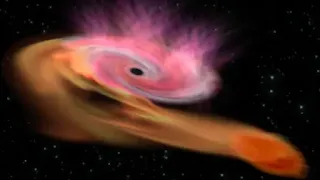Astronomers have detected a supermassive black hole, approximately 10 million times the mass of the sun, in the act of devouring a star around nine times as massive as our own. This event, designated AT2023vto, is now the largest and brightest tidal disruption event (TDE) ever observed. The TDE occurred 9 billion light-years away, setting a new benchmark for the most massive star ever seen being destroyed by a black hole.
The Spectacular Brightness of AT2023vto
What makes AT2023vto stand out among other TDEs is its incredible brightness. Despite being 9 billion light-years away, the event was visible due to its intense luminosity, a phenomenon rarely observed at such a great distance. Yvette Cendes of the University of Oregon noted that while most TDEs are detected much closer to Earth, this nonrelativistic TDE's brightness made it observable across vast cosmic distances.
Understanding Tidal Disruption Events
TDEs occur when a star’s trajectory brings it too close to a supermassive black hole. The black hole’s immense gravitational forces stretch the star vertically and compress it horizontally, leading to a process known as "spaghettification." This brutal transformation turns the star into a strand of plasma, part of which is consumed by the black hole, while the rest is ejected into space.
Cendes pointed out that these events create chaotic, bright environments around the black holes, which are typically quiet and difficult to detect. In the case of AT2023vto, the black hole's surroundings were so sparse prior to the event that it wasn’t visible from Earth.
Discovery and Initial Misidentification
AT2023vto was first detected on September 9 by the Zwicky Transient Facility (ZTF) as a sudden flash of light. Initially mistaken for a Type II supernova, the true nature of the event was uncovered by Harsh Kumar of the Center for Astrophysics Harvard & Smithsonian, who analyzed the light curve and correctly identified it as a TDE. Kumar’s work revealed the masses of both the black hole and the star, as well as the event’s staggering distance from Earth.
Radio Silence and the Potential for Future Discoveries
Subsequent observations with the Very Large Telescope (VLT) revealed no radio emissions associated with AT2023vto, a result that helped rule out the presence of relativistic jets—high-speed streams of material typically seen in other, more distant TDEs. However, Cendes hasn’t ruled out the possibility that this black hole might still emit a jet in the future. Past observations have shown that black holes can "burp" out jets long after consuming a star, a phenomenon that remains unexplained.
The Ongoing Study of AT2023vto
AT2023vto remains an active event, and astronomers are continuing to monitor it for any signs of delayed emission or other unusual activity. Cendes expressed excitement about the possibility of future discoveries, noting that there is still much to learn about the physics of TDEs. The research conducted by Cendes and her team is currently available in a pre-peer-reviewed version on arXiv, and further study may provide new insights into these extraordinary cosmic events.




.png)






0 Comments